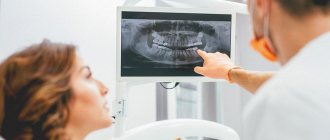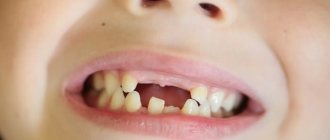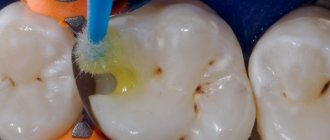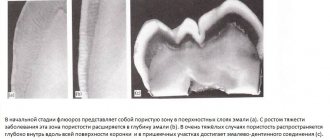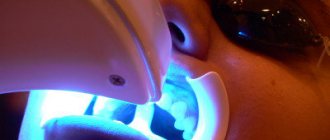Dentistry is a completely self-sufficient branch of medicine. Today dentistry is able to eliminate any problem of the dental system. Depending on the clinical situation, the patient is referred to the appropriate specialist:
- Dentist-therapist. Restoration of damaged teeth and enamel, treatment of caries, pulpitis, periodontitis, gum disease.
- Orthodontist. Bite correction.
- Orthopedist. Modern prosthetic techniques.
- Dentist-surgeon. Complex therapy requiring surgical intervention. Including implantation.
Aesthetic dentistry (restoration) is also popular, which helps to get rid of defects in teeth (chips, cracks), curvature of the dentition, damage to teeth (luxation, trauma), and pathologies of both jaws.
Brutal drills and anesthesia with side effects lasting a week are long gone. Modern methods of dental treatment are based on the use of computer technology, non-invasive therapy, professional equipment and innovative materials. This tandem allows you to carry out a complex procedure that previously took months, in just a couple of visits to the dentist. High quality and pain free.
Elimination of caries
Modern methods of caries treatment are based on non-invasive therapy, even in the most advanced cases. Often, a drill or traumatic surgical intervention is not required to remove a carious cavity.
The use of a laser is considered a revolutionary technique. The device copes well with removing damaged tooth tissue. And at the same time disinfects the treated area. For surgical operations, the laser is also indispensable, because makes neat, local cuts. This reduces the traumatic nature of the procedure and, as a consequence, the rehabilitation period.
For the treatment of caries in the initial stages, the ozone therapy procedure is effective. Ozone treatment helps get rid of any infection in the oral cavity and prevents the further spread of bacteria. Ozone is used for superficial and fissure caries. And also when the enamel darkens, when bacteria have not yet reached the dentin. The procedure is safe, painless, and is often used in pediatric dentistry.
Air blasting is also used to remove dead tooth tissue. A directed stream of fine particles helps clean the affected tooth cavity, without the use of a drill.
Bite correction
The beauty of a smile is influenced by both the whiteness of the teeth and the bite. In addition, due to the uneven distribution of the load on the teeth, malocclusion can cause serious periodontal diseases. Also, with an incorrect bite, the conditions for brushing teeth worsen, which can become one of the causes of caries. An incorrect bite makes it difficult to chew food , which can lead to diseases of the digestive system.
It is possible to correct the bite both in childhood and in adulthood. Although in adulthood this procedure has some peculiarities. Thus, getting rid of malocclusion in adults takes longer, and before treating the bite, you need to get rid of inflammatory diseases of the mouth.
permanent braces are used to treat malocclusion in adults . They are special brackets that are secured with glue to the tooth enamel. Braces systems are selected for each patient individually, which ensures wearing comfort. Now these systems are made of ceramics, which does not differ in color from enamel, or from transparent materials, which makes such systems invisible to people around them.
silicone aligners can be used to treat simple cases of malocclusion . Such mouthguards do not cause discomfort and are invisible to strangers. Orthodontic plates are used to realign the jaw bones and help break bad chewing habits. For minor malocclusions, trainers are used.
In case of severe malocclusion and incorrect position of the jaw bones, surgical intervention is necessary. Very good results can be obtained by combining the two methods, when correction with braces is performed after surgery.
Gum inflammation
Common gum diseases are gingivitis and periodontitis. In the first case, inflammation develops only in soft tissues and does not affect the dental unit. Characterized by swelling, redness and bleeding of the gums. If you do not seek dental care, gingivitis can become chronic. Or develop into periodontitis. This involves the root canals and hard tissues of the tooth. The adjacent gum peels off, and a purulent process begins in the resulting cavity. Without timely treatment of teeth, this leads to their loosening and loss.
The choice of therapeutic methods is based on the condition of the oral cavity and the severity of the pathology. As a rule, the following are used for the prevention and treatment of gum inflammation:
- Rinse procedures. After the examination, the doctor prescribes the optimal type of solution (alcohol-based antiseptics or with the addition of chlorhexidine).
- Ointments and gels (healing, anti-inflammatory, antifungal).
- Therapeutic toothpastes (anticaries, antiseptic).
- Medicines.
In most cases, soft tissue inflammation is caused by a poorly installed (polished) filling or crown. Therefore, when a disease appears, it is important not to delay visiting a doctor.
Physiotherapy (electrophoresis, darsonval, massage) is used as additional methods for treating soft tissue diseases in the oral cavity.
Content:
- Modern dental treatment - advances that have played a decisive role in the development of the industry 1.1. Use of computer technology 1.2. Laser in dentistry 1.3. Ozone in the field of dentistry 1.4. Air grinding of dental crowns 1.5. Innovative anesthetics that guarantee the absence of pain 1.6. Modern materials for filling, prosthetics and implantation
Dentistry is a field of medicine that is developing at an incredibly fast pace.
Modern methods of dental treatment surprise and delight. Today, dentists offer their patients techniques that allow them to eliminate existing functional and aesthetic deficiencies in the oral cavity without pain or harm to health. Doctors manage to “rehabilitate” seriously damaged units and return them to beautiful visuals. Even the most complex malocclusions, which negatively affect the appearance of the face, aesthetics and the process of chewing food, are eliminated by doctors at private dental clinics quite quickly.
Inflammation of the dental nerve and hard tissues of the tooth
The dental nerve (pulp) is located in the internal cavity of the tooth and contributes to the development and strengthening of the hard tissues of the tooth. Any impact, mechanical or due to infection, can cause inflammation of the nerve. In the acute stage, pulpitis is accompanied by severe pain in the tooth, especially at night. Chronic pathology does not have pronounced symptoms, pain syndrome appears periodically.
Therapy depends on the degree of damage to the pulp tissue. If the inflammation is minor, the dentist fixes the drug in the tooth. Until the disease is completely eliminated. The tooth is then filled. If the dental nerve is completely affected, the pulp is first removed under anesthesia. The dental treatment procedure includes cleaning and filling the canals. Then restoration of the upper, crown part of the tooth.
An advanced form of pulpitis provokes the development of periodontitis – inflammation of the upper part of the tooth root. The main symptoms are sharp pain when pressing on the tooth, swelling of the adjacent gums. It also occurs in acute and chronic stages. Therapy includes the procedure of depulpation and subsequent filling of the canals. If a cyst is present, in some cases an incision is made in the gum and the affected apex of the tooth root is resected.
Dental treatment during pregnancy
During pregnancy, teeth need to be treated, taking into account some of the features of treatment and anesthesia during this period. You cannot do x-rays, dental implants, or take painkillers and antibiotics, dental gels and ointments without a doctor’s prescription. Orthodontic treatment and prosthetics are not recommended. A dental hygienist can remove plaque and stone, treat gingivitis; if necessary, you should entrust the removal of teeth to a dental surgeon.
It is preferable to treat teeth in the second trimester, when there is no toxicosis, the main systems and organs of the fetus are already established. Any stress, including dental treatment, is especially dangerous in the last trimester, as it can trigger premature birth. In case of acute pain, there is no need to postpone treatment; there is a special anesthesia for pregnant women, which is characterized by the use of painkillers without adrenaline. These are hypoallergenic articaine drugs, including primacaine and ultracaine.
Enamel destruction
Pathology is usually caused by a carious process. Bacteria in the oral cavity disrupt the acid-base balance, which changes the composition of the enamel. The cause of demineralization can be an incorrect diet when there is a deficiency of calcium, phosphorus and fluorine in the body. And also due to chronic diseases associated with inability to absorb calcium and metabolic disorders.
The destruction of the tooth surface can be stopped by a remineralization procedure. But only if the hard tissues of the tooth are not damaged. That is, caries is at the initial stage.
The dental treatment procedure includes:
- Professional cleaning, removing soft and hard plaque.
- Treatment of the surface of teeth with special compounds containing calcium (8-10%).
- Installation of a temporary mouth guard with therapeutic gel (sodium fluoride, calcium hydroxide).
The course of enamel restoration includes 7-10 sessions, depending on the condition of the teeth. The procedure takes no more than half an hour, is absolutely safe and painless.
Services
| Service | Price |
| Application anesthesia | 150 rub. |
| Infiltration/conduction anesthesia | 350/450 rub. |
| Sight image on a radiovisiograph | 350 rub. |
| Panoramic photo of OPTG | RUB 1,300 |
| Removing an old filling, preparing a carious cavity | 500 rub |
| Placing a temporary filling (“Septopack”, France) | 500 rub |
| Placement of a therapeutic/isolating pad (“Dycal”/“Ionosit”, USA) | 250/350 rub. |
| Light-curing filling (“Filtek ultimate”, USA) 1 surface | RUB 1,750 |
| Light-curing filling (“Filtek ultimate”, USA) 2 surfaces | RUB 2,750 |
| Light-curing filling (“Filtek ultimate”, USA) 3 surfaces | RUR 3,750 |
| Tooth restoration under a crown (“Filtek ultimate”, USA) | RUB 4,250 |
| Artistic tooth restoration (“Filtek ultimate”, USA) | 6,500 rub. |
| Fissure sealing (“Filtek flow”, USA) | RUB 1,500 |
| Installation of fiberglass pin (Switzerland) | 3,000 rub. |
Treatment of diseased teeth is a necessity that every person faces nowadays, because a healthy smile is valued at all times and is an indicator of a person’s status. Oral diseases also affect the health of the digestive system.
The most common causes of oral diseases are poor environment, tasty but unhealthy food, and poor quality of drinking water. Therefore, in order to preserve teeth , you need to practice oral hygiene and eat food rich in minerals that are involved in the regeneration of dental tissue. You should also have regular check-ups with your doctor in order to identify problems in a timely manner. Heredity has a huge impact on dental health.
Tooth sensitivity
A painful reaction to temperature changes, or due to chemical exposure is called hyperesthesia. The cause is increased abrasion of the enamel and the presence of pathological inflammation of the soft tissues in the oral cavity.
In this case, dental treatment is based on eliminating the root cause of the disease: treating inflammation, removing low-quality or broken fillings, closing the roots of the tooth due to receding gums.
The procedure consists of daily remineralization, as well as the use of physiotherapy. Typically, it takes about two weeks for tooth enamel to restore. The patient then continues therapy at home.
Complex treatment
The Dentospas clinic employs dentists specializing in the fields of therapy, surgery, hygienics, periodontology, orthodontics, and implantology. If a patient is diagnosed with various dental health problems (for example, adentia in combination with gum disease or caries in combination with malocclusion), the doctor arranges a course of action to solve them in the optimal way. It is possible to involve doctors of a narrow specialization (implantologist, orthodontist), but at the same time the actions of specialists remain coordinated, and different problems are solved so that treatment plans complement and improve each other.
Advantages of this approach:
- Each of the patient's problems is solved systematically. He receives high-quality care, a predictable result of therapy;
- treatment is organized in an optimal way: the correct sequence of actions is built, the number of visits is reduced to a minimum, the time frame is reduced, etc.;
- The patient undergoes a comprehensive diagnosis and provides test results and health data once. He does not need to be fully examined every time a new stage of treatment begins or when the dentist moves on to the next problem.
A systematic approach to solving dental problems does not mean that all treatment will be performed at once, at the same time. On the contrary, it allows you to plan the necessary procedures and distribute them over time. They are performed on a schedule convenient for the patient, with an optimal distribution of costs for him.
Root canals
In dentistry, restoring the inside of a tooth is called endodontic treatment. It is required to preserve the dental unit during the treatment of deep stages of caries, as well as in the prosthetic procedure.
The therapy consists of preliminary extraction of the pulp, thorough cleaning and disinfection of the canals, followed by filling them. This is necessary to protect the resulting healthy tooth cavities from the penetration of bacteria. After filling the canals, the dentist restores the upper, crown part of the tooth.
If the inflammatory process has spread to the root of the tooth, then a drug is fixed before filling.
Air sanding
In modern dentistry, there are different ways to replace the drill when treating affected areas of the teeth before installing a filling. One of them is the use of air to grind the tooth surface (microabrasive processing). With air, microscopic abrasive particles are supplied to it, which grind the tooth, removing the affected parts of the tissue. The method is characterized by high precision directed air flow, which helps protect nearby tissues from damage. This method is recommended for use in the early stages of caries.
Innovative painkillers
Dental restoration using general anesthesia is a thing of the past. Modern anesthesia is applied locally and does not cause side effects.
The most popular option is sedation. An anesthetic in which the patient is conscious but does not feel pain during surgery. New types of anesthesia also act as a sedative to reduce patient anxiety during the procedure.
Modern types of painkillers are effective for no more than 1.5-2 hours. After which the patient returns to his normal life, without problems with health.
Prosthetics and implantation
A lost tooth can be restored using implantation or prosthetics. After the loss of a tooth, it must be quickly restored, because if it is missing, the load on healthy neighboring teeth increases, which can cause their destruction. The appearance of the smile deteriorates.
Dental prosthetics are cheaper than implantation. In addition, after prosthetics there are almost no exacerbations. Thanks to the development of technology, it is now possible to make prosthetics with very little involvement of adjacent teeth. In some cases, it is possible to install a prosthesis on healthy teeth. This procedure is performed with minor surgical intervention and does not cause any discomfort . Such a prosthesis is almost impossible to distinguish by eye and the patient’s smile remains beautiful.
However, it should be noted that the functionality of the prosthesis is limited. For example, patients after prosthetics cannot eat solid food, as it can cause destruction of the prosthesis. It should also be taken into account that neighboring teeth are used to attach the prosthesis, which creates a load on them and can accelerate their wear. Under the prosthesis, the bone tissue atrophies.
Bridges need to be replaced every ten years.
Unlike dentures, implants can last quite a long time. a lifetime warranty on their products . In appearance, the implant is no different from a natural tooth. After rehabilitation, the patient can eat solid foods.
Along with the advantages of implantation, there are disadvantages. This procedure is more expensive than prosthetics. Sometimes there are cases of rejection of foreign material. Implantation is a fairly long procedure that can last up to twelve months . There are also many contraindications for this procedure.
Chronic heart, liver or kidney diseases may be contraindications for the implantation procedure. Diabetes mellitus is also a cause of implantation failure. The implantation procedure involves the use of medications, which is a reason to avoid this procedure during pregnancy, as this can negatively affect the health of the child. There are also other contraindications, so you should consult your dentist when visiting the clinic for dental treatment.
Prices for dental prosthetics
If you do not visit the dentist on time, complete or partial adentia leads to disruption of the jaw apparatus, causing failures of calcium metabolism in the bones, gastric and liver dysfunctions, and abnormalities in the composition of the blood. This negatively affects the health and functionality of the oral cavity.
Dr. Razumenko’s dentistry on Preobrazhenskaya Square offers pain-free dental prosthetics in Moscow. All types of restoration are available in our clinic - partial or complete prosthetics, rehabilitation with removable and fixed structures, implantation.
To find out the price of dental prosthetics, sign up for a consultation at our dental clinic by calling: 8 (495) 380-01-38.
| Code no. | NAME OF PROCEDURES | Unit of measurement | Cost, rub. |
| 703 | Taking a two-layer A-silicone impression | 2 000,00 | |
| 716 | Temporary plastic laboratory crown | 3 000,00 | |
| 717 | Temporary plastic clinical crown (Luxatemp) | 2 500,00 | |
| 725 | The unit is metal-ceramic with a shoulder mass of 360 degrees. | 12 000,00 | |
| 735 | Single root post stump tab | 7 000,00 | |
| 757 | Partial elastic monomer-free prosthesis “Quadrotti” | 60 000,00 | |
| 764 | Immediate - prosthesis (temporary) | 45 000,00 | |
| 771 | One-sided clasp prosthesis with locking fastening | 75 000,00 | |
| 811 | Metal-free ceramics on a zirconium dioxide frame | 29 000,00 | |
| 829 | Cleaning and polishing of removable dentures | 5 500,00 |
* The prices indicated on the website are not a public offer. The exact cost of treatment can only be determined at an appointment with a doctor.
Prices for treatment in Moscow full price list
Share on social media networks:
Article Expert:
Razumenko Evgeniy Gennadievich
Chief physician and founder of the dental clinic. He has been working in aesthetic dentistry for many years, restoring teeth of any complexity with ceramic and composite restorations. Winner of competitions in aesthetic dentistry. Applies CAD/CAM technologies in prosthetics.
Work experience 22 years
